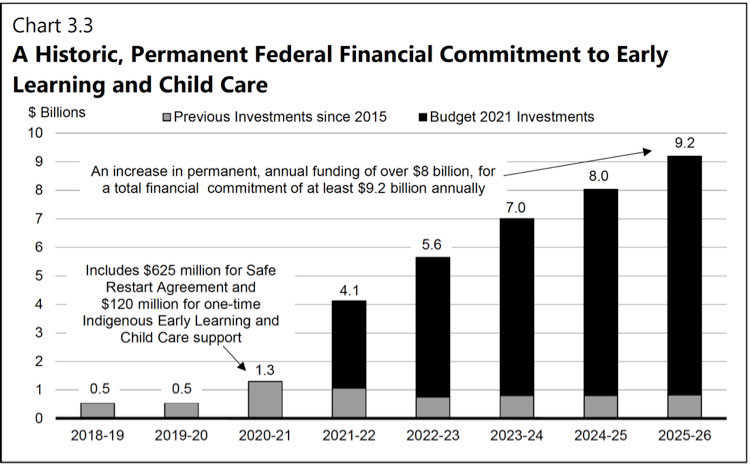You asked, we answered—Frequently Asked Questions about Canada’s historic federal budget 2021 and its plans to build a Canada-wide child care system
Since the federal budget announcement in April, there has been tremendous excitement across Canada’s Early Learning and Child Care (ELCC) sector. The $34B plan sets out a bold vision for ELCC in Canada. The Canada-wide system that we, the Canadian Child Care Federation and many other organizations in child care have been calling for is upon us. However, along with the excitement and the pending changes, we have heard your concerns and questions.
Based on what we know from Budget 2021, we include some of your pressing questions below. We will be here to continue to answer your questions and inform you on how ELCC continues to roll out for children, women, families, communities and the economy. And we will continue to advocate for our ECEs and child care workforce.
Select one of the following topics to view our Q&A:
Understanding the funding is important as it establishes the foundation for how the system will be built. Stated from the federal budget:
“Budget 2021 proposes new investments totalling up to $30 billion over the next 5 years, and $8.3 billion thereafter, for Early Learning and Child Care and Indigenous Early Learning and Child Care. Combined with previous investments announced since 2015, a minimum of $9.2 billion per year ongoing will be invested in child care, including Indigenous Early Learning and Child Care, starting in 2025-26.”
In 2017 (see the next question for more details), the federal government signed funding agreements with each of the provinces and territories specifically for ELCC. In other words, ELCC funding has been transferring from the federal government to the provinces/territories since 2017 to the present. Already promised—prior to Budget 2021—for fiscal 2021/2022 was funding of approximately $550M (includes funding for Indigenous Early Learning and Child Care (IELCC) and other ELCC expenditures like innovation funding) plus an additional $420M specifically for the ELCC workforce (see the question about the ELCC workforce below for more information). Starting in this fiscal year, as a result of the Budget 2021, this funding amount will increase to $4.1B.
While the exact formula for how the new federal funding transfers will work has yet to be announced, we can tell you that in fiscal 2020/2021, the following amounts were transferred (not including the Safe Restart funds of $625M, which were one-time and specific to COVID support and ELCC) to Canada’s provinces and territories:
It is too early to provide an estimate of what the new funding transfers will be. However, it is safe to say that they will be increased very significantly in this fiscal year as there is an additional $3.1B that has been added to budget, which includes additional funding for IELCC and other ELCC initiatives, so the $3.1B is not all transferring to the provinces and territories. Further, as the graph above shows, each and every fiscal year up until 2025/2026 increases ELCC funding as follows:
No. Every province and territory already provides funding for their child care sectors and the federal government already (since 2017) has funding agreements, called bilateral agreements, in place with ALL provinces and territories. You can find yours here. The federal government is clearly showing that they want to become a more equal funding partner through its investment and long-term funding commitment announced in Budget 2021. In fact, what the budget is doing is supporting provincial and territorial governments and there is no requirement for provincial/territorial governments to match the federal government investment.
Affordability of child care fees for families is central to the federal budget. We know that fees across Canada are unaffordable for most and the current reliance on the market-based approach has not solved any of the long-standing issues that impact and impede child care. For example, fees for an infant space range from almost $2,000/month in the GTA to a low of $181/month in Quebec. For a great analysis of fees, see the 2021 Canadian Centre for Policy Alternatives annual fee report . In federal budget 2021 there is a commitment to reducing fees across Canada by 50% by the end of 2022 and a further reduction to an average fee of $10/day across Canada by 2026.
Affordability for Families
Not at all—in fact, what is planned is a shift to supply-side funding. The plan is to move Canada’s licensed and regulated child care programs/providers away from being so dependent on parent fees—demand-side—for revenue and instead, be provided via operating funding—supply-side. How this funding will work in your province or territory will be negotiated with the federal government and communicated to you by your provincial/territorial government.
It’s all hands-on deck, so yes, all regulated and licensed child care providers including those incorporated as not-for-profit and for-profit organizations and family/home programs are to be a part of the Canada-wide change described above. All will be a part of the move to a 50% reduction in parent fees in the first year, and the next phase to the average of $10/day fees.
Yes, this is about all licensed and/or regulated programs/providers and you are an important part of Canada’s child care sector and system building.
The federal budget is not as specific about School Age/Out of School Care as it is about care for 0-5 year old children. However, the following statement signals that something will happen:
“Over the next five years, the government will work with provinces and territories to make meaningful progress towards a system that works for families…..federal funding would allow for….progress in improving and expanding before- and after-school care in order to provide more flexibility for working parents.”
Canada’s federal government already directly funds eligible families via its Canada Child Benefit program, a tax-free monthly payment to help with the costs of raising children up to 18 years of age. In order to build a high quality, affordable, accessible and inclusive child care system, child care programs/providers require supply-side funding and not having to rely on parent fees, which is why the sector is in its current state.
Supply-Side Funding and Operations
The best examples of supply-side funding are the education system and the health care system. They both receive their funding from governments, directly from provincial/territorial governments and via dedicated transfers from the federal government to provincial/territorial governments. Neither system depends on, for example, parents to pay direct, additional costs for service. As for budget 2021 and ELCC, there will still be a parent fee, but it will be a fraction of what is generally being charged for most families and that portion of your revenue will be provided via operating funding.
We know that collecting parent fees can be a real challenge for child care programs/providers. Bad debts and write-offs are very real in Canada’s ELCC sector. Moving to supply side funding will help to significantly reduce this vulnerability—and of course, will absolutely support the economic security and well-being of families.
Again, it’s all hands-on deck. We know that pre-pandemic there were not enough high-quality spaces for children across Canada. As we move to restarting and recovering our economy and society, families will need all the current spaces and even more. With affordability, we expect higher demand for child care.
All licensed and/or regulated child care in Canada have minimal regulations, safety and health policies that they must follow in order to operate. They do not make your program government run, but most certainly it is government regulated and/or licensed. There is nothing in the federal budget that talks about making child care programs/providers government run. Supported and funded by government, yes.
Indigenous Early Learning and Child Care
The federal government negotiated a very historic and important nation to nation agreement in 2018 called the Indigenous Early Learning and Child Care Framework (IELCC). This Framework sets out a shared vision, principles and an Indigenous governed path forward for Indigenous early learning and child care— where their children have the opportunity to experience culturally rooted, quality early learning and child care programming. Budget 2021 provides additional funding to current federal funding for the implementation of the IELCC. This is incredibly important—essential—for reconciliation and self-determination.
From Budget 2021:
“Budget 2021 builds on this framework, and on recent investments in the 2020 Fall Economic Statement, to continue the progress towards an early learning and child care system that meets the needs of Indigenous families, wherever they live. A proposed investment of $2.5 billion over the next five years in Indigenous Early Learning and Child Care will include: $1.4 billion over five years, starting in 2021-22, and $385 million ongoing, to ensure that more Indigenous families have access to high-quality programming. Guided by Indigenous priorities and distinctions-based envelopes, this investment will build Indigenous governance capacity and allow providers to offer more flexible and full-time hours of care, build, train and retain a skilled workforce, and create up to 3,300 new spaces. This will include new investments in Aboriginal Head Start in Urban and Northern Communities.”
Canada’s ELCC Workforce
We have to go back to the federal government’s Fall Economic Statement (FES) as well as the current federal budget for this answer. In the FES, the federal government committed $420M to be transferred to the provinces and territories specifically for Canada’s ELCC workforce. These funds will be transferred in this fiscal year of 2021/2022. Additionally, in the federal budget, there is very clear language as to the importance and value of Canada’s ELCC workforce and how essential you all are:
“A growing, qualified workforce—with provincial and territorial partners, the government will work to ensure that early childhood educators are at the heart of the system, by valuing their work and providing them with the training and development opportunities needed to support their growth and the growth of a quality system of child care.”
Simply put, quality child care cannot happen by only addressing affordability for families. There must be investments and planning specifically for Canada’s ELCC workforce. As we continue to move forward, along with the CCCF and child care advocates, we will work to ensure ELCC workforce strategies are in place. As essential as affordability is, we need improved provincial/territorial wage grids/scales to better compensate and recognize the importance and value of the ELCC workforce. This means enhanced education and training opportunities/pathways, recruitment and retention strategies that support pedagogy and quality for children and the economic security of the ELCC workforce—making ELCC a career destination rather than a stop-over.
This important work will need to be a continual focus for all — provincially, territorially and federally.
Accessibility and Inclusion
Budget 2021 provides $29.2M over two years, 2021-2023, to support child care programs to improve their physical accessibility. These funds could support things such as the construction of ramps and accessible doors, washrooms, and play structures.
Future Growth and Spaces
In Budget 2021, the federal government specifies its intent for future growth in partnership with the provinces and territories:
“The next five years of the plan will also focus on building the right foundations for a community-based and truly Canada-wide system of child care. This includes working with provinces and territories to support primarily not-for-profit sector child care providers to grow quality spaces across the country while ensuring that families in all licensed spaces benefit from more affordable child care.”
Not at all. As previously answered, there will be support both in the immediate and in the future for all.
Kindergarten and Junior Kindergarten
No, at least not specific to the federal government’s stated plans for Budget 2021. If a province/territory decide to implement or enhance current full day kindergarten or junior kindergarten/nursery programs, then that will be their initiative. The Canada-wide child care system is specific to exactly that, child care.
How and When?
There are already agreements with the provinces and territories on ELCC. For this fiscal year there was already $400M (approx.) budgeted to be transferred via these agreements. An additional $420M is also to be transferred for the ELCC workforce plus funds for the IELCC. The federal budget allocated an additional $3.1B for ELCC this fiscal year making the total funding for 2021/2022 $4.1B.
The additional funding is being negotiated with the provinces and territories. This will take time, but with an urgency to reducing parent fees quickly and supporting the ELCC workforce in order to continue to stabilize Canada’s ELCC sector which has been severely impacted by COVID. System building is central to the federal government’s budget.
How it happens will evolve, it will be in the details of the negotiations and agreements.
We will keep you posted and will share information as it happens. Follow us on Facebook or Twitter to keep up with our latest announcement, or join our newsletter.











